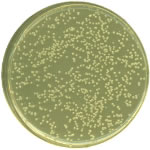Staphylococcus epidermidis
This MLST scheme is as published in Thomas et al. Strain data will be available shortly
- Organism Specific Information
- Concatenate Sequences
- Download Alleles
- Download ST’s
- Compare profile to refset
- Draw tree using own MLST data
- download as MS Excel
- download as MS Access
- S.epidermidis Links
- eBURST V3
- Contact Curator
Staphylococcus epidermidis is a coagulase-negative type of staphylococcus, a representative of the normal microflora of human skin. Some strains of Staphylococcus epidermidis, being safe when on the skin, cause surgical infections that are deadly to humans after surgical interventions.
Epidermal staphylococcus in the bacteria taxonomy
The species epidermal staphylococcus belongs to the Staphylococcus strain, which is part of the family Staphylococcaceae, Bacillales, class Bacilli, type Firmicutes, Terrabacteria group.
According to genetic and physiological characteristics, S. epidermidis is adjoined by the following species of staphylococci: S. capitis, S. warneri, S. haemolyticus, S. hominis, and S. saccharolyticus. Based on this proximity, all of these species are combined into a group called Staphylococcus epidermidis. All staphylococci of this group, unlike the most pathogenic Staphylococcus aureus, are not able to produce coagulase – an enzyme that causes coagulation of blood plasma.
General information
Epidermal staphylococci have the correct spherical shape and size from 0.5 to 1.5 μm. Mainly 2 and 4 bacteria are located. Optimum temperature ranges 30-37 °C.
Antibiotics active against epidermal staphylococcus
Antibacterial agents that are active against epidermal staphylococcus: clarithromycin, josamycin, amoxicillin, rifaximin, furazolidone, nifuroxazide, vancomycin, clindamycin, lincomycin, azithromycin, norfloxacin, ofl. Methicillin-sensitive strains of epidermal staphylococci are sensitive to levofloxacin and moxifloxacin.
Staphylococcus infection idntification
To find out the causes of cocci infection, it is very important to know the sources by which they are introduced into the body:
- air-borne way. Thus, a patient with pneumonia can transfer the bacterium. During a cough, cocci are in the air and settle on interior items.
- food inoculation. Staphylococcus aureus can often live in poor-quality meat and unwashed foods. The first symptom is food poisoning. If measures are not taken in time, severe intoxication of the body can occur with all further negative consequences.
- neglegence of personal hygiene. The use of things and personal hygiene products of a person with staphylococcus aureus, especially by persons with poor immunity.
damage to the skin and mucous membranes. Even through microtraumas, the bacterium easily penetrates the body and multiplies rapidly in it. A special risk group is patients with poor immunity in the postoperative state.The key factors for the progression of staphylococcus are: weak immunity, immunosuppressants, prolonged use of antibiotics, some chronic diseases.
How to identify staphylococcus?
The main detection method is bacterial culture. For its implementation, there is a sampling of materials in which the bacterium is localized. The result of this test reveals the type of cocci and its quantity.


